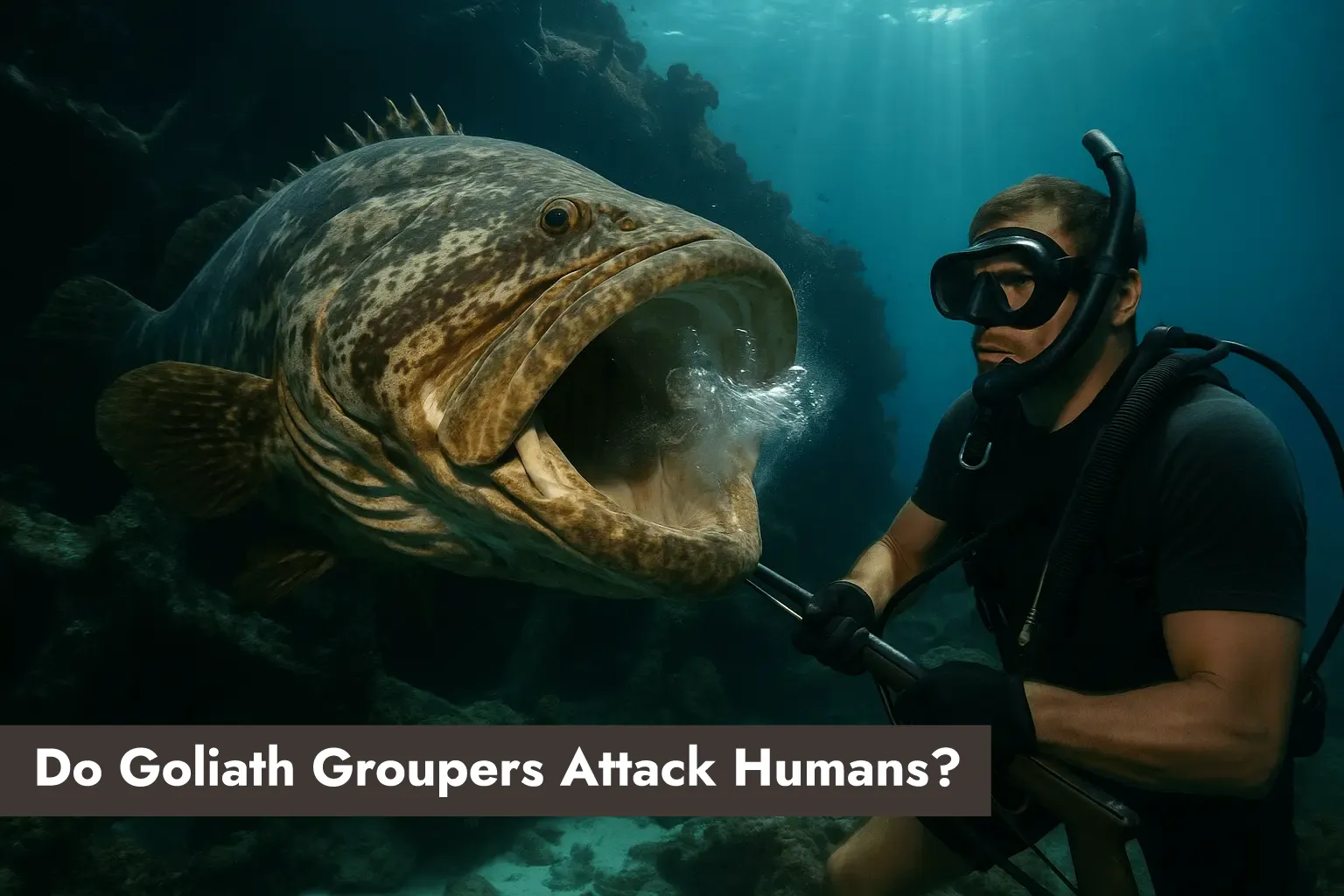Do Goliath Groupers Attack Humans?
Introduction:
Imagine diving into the deep blue, surrounded by the silence of the ocean, when suddenly, a massive Goliath Grouper—weighing up to 800 pounds—emerges from the shadows. Your heart races. Do Goliath Groupers attack humans, or is their size simply intimidating? These questions often come up when exploring aquatic animals known for their massive size and unique behavior.
Despite their monstrous appearance, Goliath Grouper’s behavior is more curious than aggressive. These giants, found in warm Atlantic waters, prefer lurking near coral reefs and shipwrecks, ambushing prey with their powerful suction. While there have been Goliath Grouper attack incidents, most involve fish theft from spearfishermen rather than direct aggression.
For divers and fishermen, understanding these creatures is key to avoiding unnecessary fear. Instead of viewing them as threats, it’s important to recognize them as gentle but strong predators that demand respect. So, are Goliath Groupers dangerous to humans? Let’s separate fact from fiction.
What is a Goliath Grouper? (Scientific & Biological Insights)
The Goliath Grouper (Epinephelus itajara) is one of the largest reef fish in the ocean. How big do Goliath Groupers get? These giants can grow up to 8 feet long and weigh over 800 pounds. Their sheer size and wide, gaping mouths make them look intimidating, but their behavior is far from aggressive.
Goliath Grouper Size and Behavior
Despite their bulk, Goliath Grouper’s behavior is generally calm and inquisitive. They are slow-moving ambush predators, using their powerful suction to swallow prey whole. While they have strong jaws, they rarely use them against humans.
Where Do Goliath Groupers Live?
These giants thrive in warm, tropical waters of the Atlantic Ocean, particularly near Florida, the Gulf of Mexico, and the Caribbean. Their preferred Goliath Grouper habitat includes coral reefs, shipwrecks, and rocky outcroppings, where they can hide and hunt.
Feeding Habits: Opportunistic but Not Aggressive
Goliath Groupers eat crustaceans, small fish, and even octopuses. Instead of chasing prey, they rely on their vacuum-like mouths to suck in food. While they might steal a catch from a diver, they are not known for aggressive hunting.
Historical Accounts: Have Goliath Groupers Ever Attacked Humans?
The Goliath Grouper attack history is filled with myths and exaggerations. Stories of these massive fish dragging divers underwater or snatching fishermen’s catches have fueled their fearsome reputation. But how much of this is true?
Documented Goliath Grouper Attacks
Despite their size, documented Goliath Grouper attacks on humans are extremely rare. Most encounters involve startled divers or fishermen losing their catch, not intentional aggression. These groupers are more likely to steal a struggling fish than to attack a person.
Has a Goliath Grouper Killed a Human?
There is no verified record of a Goliath Grouper killing a human. While their immense size and powerful bite could cause injury, they do not view humans as prey. Any so-called “attack” is usually a case of mistaken identity or a defensive reaction.
Why Do They Seem So Dangerous?
A giant fish lunging at a diver’s catch can be intimidating, but it’s not aggression—it’s opportunism. Their sheer power and sudden movements make them seem scarier than they really are.
Goliath Grouper Behavior: Aggressive or Gentle Giants?
Are Goliath Groupers Aggressive?
Despite their enormous size, Goliath Groupers are not aggressive toward humans. Their temperament is generally calm and curious, and they often approach divers out of sheer curiosity, not hostility.
Do Goliath Groupers Bite?
While they have powerful jaws, Goliath Groupers rarely bite humans. They rely on a suction feeding method, pulling prey into their mouths rather than attacking with force. Any bite incidents are typically accidental—often involving spearfishermen holding freshly caught fish.
Are Goliath Groupers Friendly?
Many divers describe Goliath Groupers as friendly and even playful. They often hover nearby, inspecting divers and their equipment. However, their large size and sudden movements can be startling if you’re not expecting them.
Why Do They Steal Fish from Spearfishermen?
Goliath Groupers have learned that spearfishermen provide an easy meal. The vibrations from a speared fish attract them, leading to quick snatch-and-grab situations. This behavior isn’t aggression—just opportunistic feeding.
When Might a Goliath Grouper Act Defensively?
Like any wild animal, Goliath Groupers may react defensively if they feel threatened. If cornered or provoked, they can produce a loud, booming sound as a warning. However, they almost always prefer to retreat rather than fight.
Can a Goliath Grouper Attack You? (Analyzing Potential Threats)
Can Goliath Groupers Attack Humans?
Technically, yes—Goliath Groupers can attack humans, but it’s incredibly rare. They don’t see people as prey, and most human encounters with Goliath Groupers involve curiosity, not aggression. Any so-called “attacks” are usually misunderstandings or food-related interactions.
Are Goliath Groupers Dangerous?
So, how dangerous are Goliath Groupers? Their size alone makes them capable of accidentally injuring a diver, but they are not inherently dangerous. Most risks occur when a diver provokes, corners, or startles one, which could lead to a defensive reaction.
Do Goliath Grouper Bites Happen?
Though Goliath Grouper bites are possible, they don’t typically bite humans on purpose. Their mouths are built for suction feeding, meaning they vacuum up prey rather than biting down with force. However, a diver holding a struggling fish could accidentally get their hand pulled into a Goliath Grouper’s mouth.
The Reality of Their Suction Feeding Mechanism
A Goliath Grouper’s feeding strike is powerful, creating a strong vacuum force. If a diver is too close while they are feeding, they might feel the pull of this suction. While this could cause a moment of panic, it’s not an attack—just the result of a fish doing what it does best: eating.
Viral Videos & Internet Myths: Separating Fact from Fiction
The Truth Behind Goliath Grouper Attack Videos
The internet is full of Goliath Grouper attack videos showing these massive fish snatching sharks, stealing fish, or surprising divers. While these clips are dramatic, they often lack context, making the fish seem more aggressive than they really are.
Does a Goliath Grouper Eat Sharks?
One of the most viral clips shows a Goliath Grouper eating a shark in a single gulp. While impressive, this isn’t proof of aggression—it’s just opportunistic feeding. The shark was already caught on a fishing line, making it an easy target for the grouper.
Fishermen vs. Goliath Grouper: Who’s Really the Aggressor?
Many fishermen have lost their catches to these giants, leading to frustration and exaggerated stories. However, the biggest Goliath Groupers caught are often released due to conservation laws, showing that humans are more of a threat to them than vice versa.
What Do Real Divers Say?
Most experienced divers debunk the myths surrounding these fish. Instead of attacking, Goliath Groupers are often calm and curious, only reacting when startled or provoked. The reality? They’re gentle giants, not ocean monsters.
Survival Tips: How to Stay Safe Around Goliath Groupers
How to Avoid a Goliath Grouper Attack
While actual attacks are rare, knowing how to interact with Goliath Groupers can prevent unwanted encounters. The key is respecting their space, staying calm, and avoiding sudden movements. Most encounters are harmless and even fascinating if handled correctly.
Safety Tips for Divers and Snorkelers
- Stay relaxed—they are naturally curious but not aggressive.
- Don’t chase or corner them—this can make them feel threatened.
- Avoid spearfishing near them—they might try to steal your catch.
What to Do If a Goliath Grouper Approaches
If a Goliath Grouper gets too close, remain calm and still. They often approach out of curiosity, not aggression. If necessary, slowly back away without making sudden splashes.
Do’s and Don’ts in the Wild
- Do observe from a distance and appreciate their presence.
- Do respect their habitat and avoid touching them.
- Don’t dangle shiny objects or fish that might attract them.
- Don’t panic or flail your arms—this could startle them.
By following these simple steps, you can enjoy a safe and unforgettable encounter with one of the ocean’s most impressive giants.
Conservation Status: Why Goliath Groupers Need Protection, Not Fear
Goliath Grouper Conservation Status: From Overfished to Protected
Once abundant, Goliath Groupers were nearly wiped out due to overfishing in the 1970s and 1980s. Their slow growth and late maturity made them vulnerable, leading to strict protections to help their population recover. The U.S. Fish and Wildlife Service shares fascinating insights into their behavior and why protecting this species is so important.
Are Goliath Groupers Endangered?
While no longer classified as critically endangered, Goliath Groupers are still considered vulnerable. Their numbers have improved, but threats like illegal fishing and habitat destruction continue to put them at risk.
Goliath Grouper Fishing Laws: Can You Catch a Goliath Grouper?
In many places, Goliath Grouper fishing laws prohibit harvesting. In the U.S., catching and keeping them has been banned for decades, though some states have recently introduced limited harvest programs. Catch-and-release is still encouraged to protect their population.
Why Goliath Groupers Matter to the Ecosystem
As apex predators, Goliath Groupers help maintain reef balance by controlling populations of smaller fish and crustaceans. Protecting them ensures a healthier ocean ecosystem, proving that these gentle giants deserve respect, not fear.
Conclusion: Are Goliath Groupers a Threat to Humans?
Do Goliath Groupers Pose a Danger to Humans?
Despite their enormous size, Goliath Groupers are not a real threat to humans. They are curious, not aggressive, and most encounters are harmless. The misconceptions about Goliath Groupers stem from their sheer size and viral videos that exaggerate their behavior.
The Truth About Goliath Grouper’s Attacks
There is no evidence of Goliath Groupers intentionally attacking humans. Most so-called attacks are just fish-stealing incidents or cases where a diver got too close. Understanding their behavior helps eliminate unnecessary fear.
Final Takeaways for Divers, Fishermen, and Adventurers
- Respect their space and observe from a distance.
- Avoid spearfishing near them to prevent accidental encounters.
- Promote responsible wildlife interactions and conservation efforts.
Rather than fearing these gentle giants, we should appreciate their role in the ocean. The truth about Goliath Grouper’s attacks is simple—they are not monsters, just misunderstood marvels of the deep.



